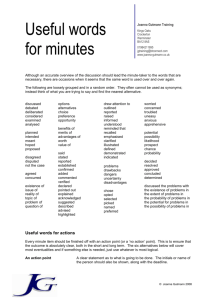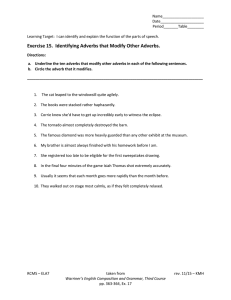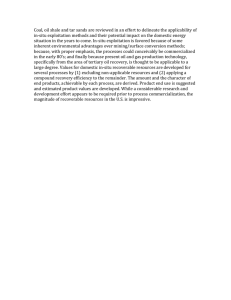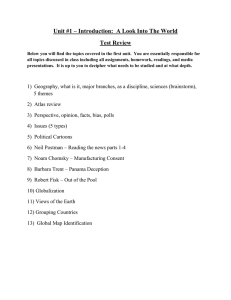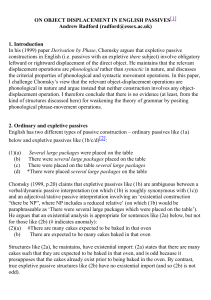A-movement in Icelandic This paper is an investigation of Object
advertisement
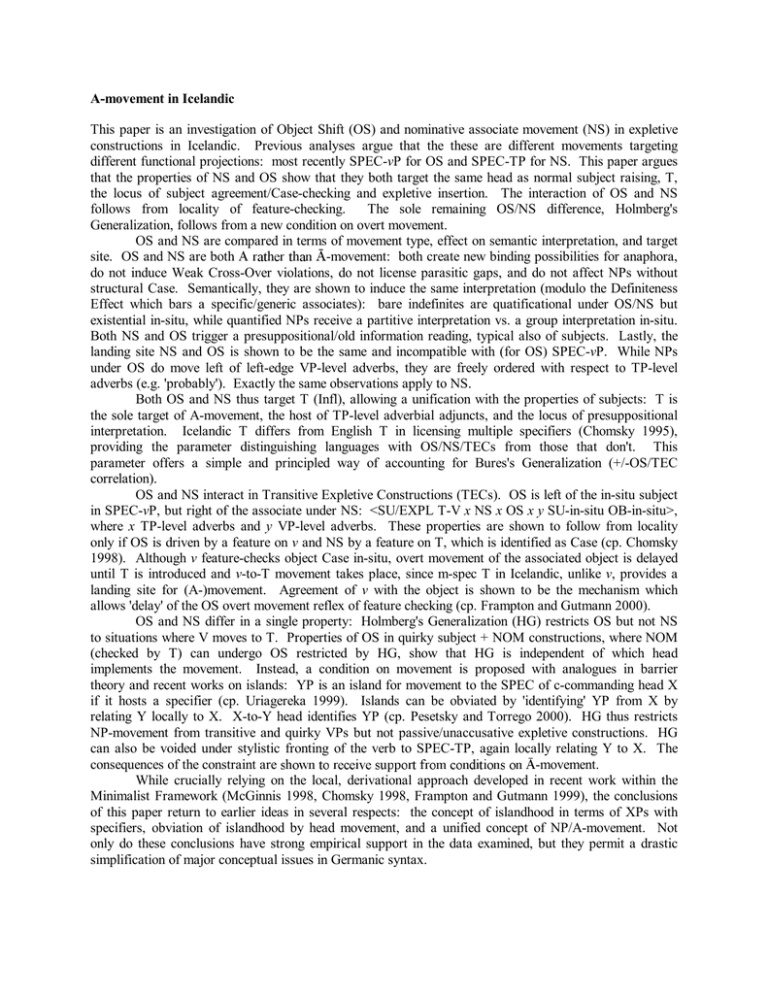
A-movement in Icelandic This paper is an investigation of Object Shift (OS) and nominative associate movement (NS) in expletive constructions in Icelandic. Previous analyses argue that the these are different movements targeting different functional projections: most recently SPEC-vP for OS and SPEC-TP for NS. This paper argues that the properties of NS and OS show that they both target the same head as normal subject raising, T, the locus of subject agreement/Case-checking and expletive insertion. The interaction of OS and NS follows from locality of feature-checking. The sole remaining OS/NS difference, Holmberg's Generalization, follows from a new condition on overt movement. OS and NS are compared in terms of movement type, effect on semantic interpretation, and target site. OS and NS are both -movement: both create new binding possibilities for anaphora, do not induce Weak Cross-Over violations, do not license parasitic gaps, and do not affect NPs without structural Case. Semantically, they are shown to induce the same interpretation (modulo the Definiteness Effect which bars a specific/generic associates): bare indefinites are quatificational under OS/NS but existential in-situ, while quantified NPs receive a partitive interpretation vs. a group interpretation in-situ. Both NS and OS trigger a presuppositional/old information reading, typical also of subjects. Lastly, the landing site NS and OS is shown to be the same and incompatible with (for OS) SPEC-vP. While NPs under OS do move left of left-edge VP-level adverbs, they are freely ordered with respect to TP-level adverbs (e.g. 'probably'). Exactly the same observations apply to NS. Both OS and NS thus target T (Infl), allowing a unification with the properties of subjects: T is the sole target of A-movement, the host of TP-level adverbial adjuncts, and the locus of presuppositional interpretation. Icelandic T differs from English T in licensing multiple specifiers (Chomsky 1995), providing the parameter distinguishing languages with OS/NS/TECs from those that don't. This parameter offers a simple and principled way of accounting for Bures's Generalization (+/-OS/TEC correlation). OS and NS interact in Transitive Expletive Constructions (TECs). OS is left of the in-situ subject in SPEC-vP, but right of the associate under NS: <SU/EXPL T-V x NS x OS x y SU-in-situ OB-in-situ>, where x TP-level adverbs and y VP-level adverbs. These properties are shown to follow from locality only if OS is driven by a feature on v and NS by a feature on T, which is identified as Case (cp. Chomsky 1998). Although v feature-checks object Case in-situ, overt movement of the associated object is delayed until T is introduced and v-to-T movement takes place, since m-spec T in Icelandic, unlike v, provides a landing site for (A-)movement. Agreement of v with the object is shown to be the mechanism which allows 'delay' of the OS overt movement reflex of feature checking (cp. Frampton and Gutmann 2000). OS and NS differ in a single property: Holmberg's Generalization (HG) restricts OS but not NS to situations where V moves to T. Properties of OS in quirky subject + NOM constructions, where NOM (checked by T) can undergo OS restricted by HG, show that HG is independent of which head implements the movement. Instead, a condition on movement is proposed with analogues in barrier theory and recent works on islands: YP is an island for movement to the SPEC of c-commanding head X if it hosts a specifier (cp. Uriagereka 1999). Islands can be obviated by 'identifying' YP from X by relating Y locally to X. X-to-Y head identifies YP (cp. Pesetsky and Torrego 2000). HG thus restricts NP-movement from transitive and quirky VPs but not passive/unaccusative expletive constructions. HG can also be voided under stylistic fronting of the verb to SPEC-TP, again locally relating Y to X. The consequences of the constraint are -movement. While crucially relying on the local, derivational approach developed in recent work within the Minimalist Framework (McGinnis 1998, Chomsky 1998, Frampton and Gutmann 1999), the conclusions of this paper return to earlier ideas in several respects: the concept of islandhood in terms of XPs with specifiers, obviation of islandhood by head movement, and a unified concept of NP/A-movement. Not only do these conclusions have strong empirical support in the data examined, but they permit a drastic simplification of major conceptual issues in Germanic syntax. References Chomsky, N. 1995. Categories and transformations. In The minimalist program, . MIT Press: Cambridge, Mass. Chomsky, N. 1998. Minimalist Inquiries. MITWPL 15: Cambridge, Mass. Frampton, J., and S. Gutmann. 1999. 'Cyclic computation: A computationally efficient minimalist syntax'. Syntax 2:1, 1-27. Frampton, J. and S. Gutmann. 2000. Agreement as feature-unification. Ms., Northeastern University. McGinnis, Martha. 1998. Locality in A-movement. Doctoral Dissertation, MIT: Cambridge, Mass. Pesetsky, David, and Esther Torrego. 2000. T C movement: Causes and consequences. Ms., MIT. Uriagereka, Juan. 1999. Multiple spell-out. In Working Minimalism, S. D. Epstein and N. Hornstein (eds.). MIT Press: Cambridge, Mass.
